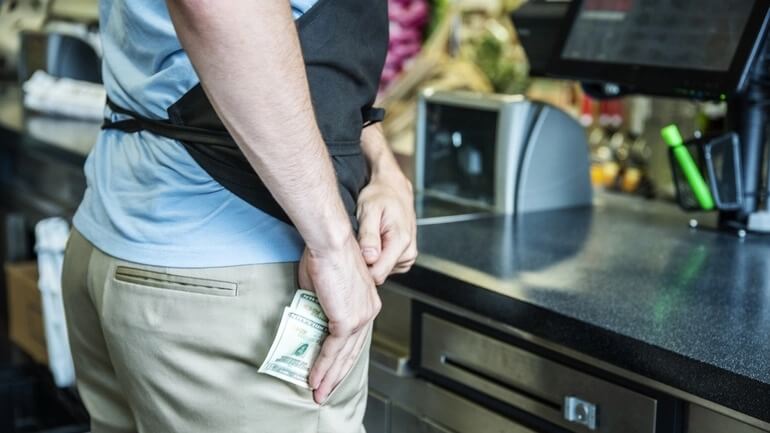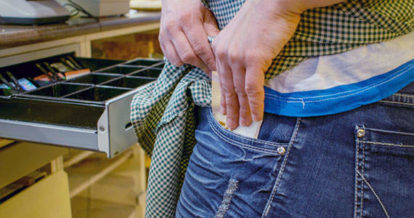Owning a restaurant can be an incredible experience – serving delicious food and building a team that works hard to deliver an excellent guest experience. And often, this is the case. But what you don’t see through this rose-colored lens is a very real threat to your business – employee theft. This is why it’s crucial to brush up on your knowledge of restaurant loss prevention and put a strategy in place to protect your business.
Restaurant employee theft is more common than you may think. In fact, it accounts for 75% of all inventory shortages and 4% of sales, according to the National Restaurant Association. To make matters worse, about three-quarters of staff steal from their workplace on at least one occasion – a fact that’s bound to leave a bad taste in your mouth.
In this guide to restaurant loss prevention, you’ll learn how to curb employee theft in restaurants to make your business safer and more profitable. We’ll cover:
- What is loss prevention?
- Common types of restaurant employee theft
- 11 restaurant loss prevention tips

What is Loss Prevention?
Let’s start by answering a basic question: what is loss prevention?
Loss prevention refers to your restaurant’s efforts to reduce any and all revenue losses. This includes taking simple steps, like ensuring you don’t order too much produce and ending up with excessive food waste.
Reducing losses can also strike a more serious chord, including restaurant theft prevention tactics to combat dine-and-dash situations, credit card fraud, and employee theft in restaurants. Let’s turn our attention to the last point.
Common Types of Restaurant Employee Theft
Unfortunately, theft occurs frequently in restaurants, and the saying “one bad apple spoils the barrel” rings true here. Research shows that the likelihood of one server stealing increases if a co-worker is stealing. And if a new hire sees a co-worker stealing within their first five months on the job, chances are they’ll make it a habit, too.
With that in mind, here are some of the most common types of employee theft in restaurants to familiarize yourself with so you can spot them and stop them.
1. Short Ringing
Also known as under-ringing of sales, here’s how short ringing typically plays out. A customer pays in cash at the bar for a $15 2-oz cocktail, but the bartender enters the order into your POS system as a $10 1-oz cocktail and pockets the other $5, leaving no paper trail of the theft. Talk about an unhappy hour.
2. Cash Register Skimming
Skimming cash from the register involves staff stealing cash from sales that aren’t recorded in your restaurant’s books. For example, a customer orders a piece of pie from your dessert counter and the server gives them the pie but doesn’t ring it in, then keeps the cash instead of putting it in your register. In other brazen cases, skimming can also include stealing small amounts of cash outright from your register.
3. Comping Too Many Orders
Giving guests complimentary food and drinks (comping) is standard practice in most restaurants. However, if this starts happening too often, you need to address it in your restaurant loss prevention strategy. You don’t want your overly generous employees giving free appetizers to their friends every time they eat at your restaurant.
4. Voiding Sales After Closing
Don’t let your guard down just because it’s the end of the day – theft can and does occur after hours. For example, your supervisor on duty could sneakily void one item from several orders and pocket the total instead of including it in the nightly cash-out.
11 Restaurant Loss Prevention Tips
If you’ve experienced a situation at your restaurant like the ones we’ve just discussed, it’s undoubtedly tough to handle. The silver lining is that since employee theft in restaurants is a common problem, there are a number of strategies you can employ to address the issue. Let’s walk through these restaurant loss prevention tips together.
1. Pay Staff Well and Provide Benefits
While some employees may steal simply for kicks, others may turn to theft because they’re having trouble making ends meet. As tipped workers, restaurant staff are often paid low wages and rely on the extra cash they receive from customers. However, over 80% of restaurant workers have reported a decrease in tips during the COVID-19 pandemic, and almost two-thirds of those workers have seen their tips slashed at least in half.
By paying your employees a solid wage and providing health benefits, you’ll help them weather tough times and protect your restaurant against theft driven by desperation.
2. Create a Clear Employee Meal Policy
Staff perks like discounted or free meals are an expectation in most restaurants, but they have several benefits for you as a restaurateur, too. Offering employee meal deals can boost morale, help staff become more familiar with your cuisine, and discourage theft. Why steal food when you’re getting a sweet discount?
Just remember to keep track of employee meals with a specific policy including a discount percentage and dollar amount allotted per month, and monitor the system to make sure your staff aren’t abusing the perk.
3. Offer Proper Onboarding and Training
Your team is the main ingredient in the recipe for your restaurant’s success, which is why it’s crucial to have a solid onboarding process in place. When it’s done well, onboarding can help you keep your restaurant turnover rate low and engagement high – and enable you to prevent restaurant employee theft. But how do you get it right?
Creating a new hire checklist for restaurant employees can help you streamline the onboarding process and ensure all of your new hires have a clear understanding of the rules and procedures at your restaurant – including the repercussions of theft. Having these conversations upfront can help you avoid worse situations in the future.
4. Refine Your Cash Handling Procedures
It seems like Biggie knew a thing or two about the restaurant industry when he said, “mo’ money mo’ problems.” As a restaurateur, you don’t want too much cash in your register at any given time. Crank up the volume on your restaurant loss prevention strategy by placing drop boxes close to your register so it won’t be overflowing with bills and at risk for skimming.
You can also improve your cash handling practices by separating cash management duties so that multiple employees are involved. This way, no single staff member will be able to fudge their sales figures.

5. Adjust Staff Settings and Controls
A restaurant POS system makes it easier than ever to control what employees can and cannot do when punching in orders and taking payments. With the option to set up each staff member with specific permissions based on their role, you can have greater oversight and ensure your cash is going into the register – and not into anyone’s pocket.
A POS with customizable controls can help you avoid sneaky scams. For example, a bartender opens a table, punches in three rounds of drinks, and prints the bill without sending the drinks to the bar. Then, they delete a round of drinks before closing the bill, keeping the cash. A POS with staff settings and controls would easily stop theft like this because manager permission would be required to print the check with unsent items.
6. Review POS Reports
Simply having a great POS system isn’t enough to prevent employee theft in restaurants. You also need to review your POS reports regularly to identify where theft is happening and where profit is leaking from your business. As part of your restaurant loss prevention strategy, use transaction reports to see if any transactions were removed or modified after they were finalized. If you spot a transaction that was deleted, follow up on it with your staff.
You should also run reports on how many voids and discounts were performed, how many times the cash drawer was opened, and who was responsible for each instance. In addition, a credit card tips report will show tips entered, allowing you to nip in the bud anyone trying to pad their pockets on the customer’s dime. This sheds light on employees’ actions and holds them accountable.
7. Implement Proper Inventory Tracking
Most restaurateurs know that inventory tracking works best when it’s consistently and correctly monitored, and by comparing what items have been sold to what’s in and out of stock. Using a POS-integrated inventory tracking solution can help you monitor your stock and catch any instances of employee theft in your restaurant.
For example, you may notice that a few orders of chicken wings go missing from your physical inventory every couple of weeks on Friday nights. You can compare your inventory report to your shift report to see who was working during those times, and then talk to them to find out what’s happening to the disappearing late-night snacks.
8. Monitor Employee Performance
Theft can extend beyond staff stealing inventory. This is why it’s essential to evaluate your employees’ attendance vs. scheduled hours, as well as break times, to ensure they’re not “stealing time.” A POS with a setting that tracks these changes can be helpful to spot anyone attempting to be paid for hours they didn’t work.
For example, let’s say one of your kitchen staff left at 10 p.m. on Wednesday night and clocked out, but then a shift supervisor went into their hours and changed the clock out time to 2 a.m. If your POS tracks these changes, there would be a note indicating that the shift was modified, leaving a visible record, and making it easy to approach the offending parties to request an explanation.
9. Reevaluate Your Accounting Practices
Restaurant theft can also occur during end-of-day reconciliations and even involve managers’ underreporting earnings. Reviewing your accounting procedures and making sure you have the right technology to support your restaurant’s financial health is a wise move. You may also want to consider getting a third-party expert to review your restaurant bookkeeping to identify theft and protect against future revenue losses.
10. Upgrade Your Security Procedures and Technology
While you don’t want to create an unwelcoming environment, in some cases you’ll need to get yourself a bit of backup by installing security cameras in your restaurant to deter would-be thieves. It’s also a good idea to upgrade your restaurant’s tech so you can manage keys and swipe cards with digital records, instead of the old school way. When implementing digital technology, it’s important to look into cyber insurance due to the increase of restaurant cyber security risks.
11. Promote Open Communication
Don’t forget the human element in your restaurant loss prevention strategy. Being an approachable boss can go a long way to shut down employee theft in restaurants. Promote a positive work environment where your staff feel comfortable asking for help when they need it, and create a culture of accountability to help keep everyone honest.
Level Up Your Loss Prevention Strategy
You now have an answer to the question, “what is loss prevention” and 11 solid loss prevention tips to help you guard against restaurant employee theft. Your next step? If you don’t have one already, a POS that offers control and insight into your staff’s actions is the most important tool you can leverage for restaurant loss prevention.
Get the Complete Guide to Restaurant Reservations
Sign up for our free weekly TouchBistro Newsletter







